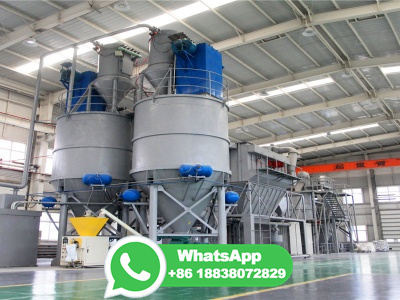
The Bayer process for alumina production generates more than 160 million tons of bauxite residue annually. The current global stockpiles of bauxite residue have reached more than 4 billion tons with less than 2% annual recycling rate. Critical elements such as Sc and Y present an opportunity to explore bauxite residue as a secondary resource; however, low concentration affects the process ...
WhatsApp: +86 18838072829
The Bayer process is used worldwide for the alumina production. This process involves the alkaline leaching of bauxite to extract Al, followed by the precipitation of Al (OH)3 to recycle the ...
WhatsApp: +86 18838072829
The Bayer Process, developed by Carl Josef Bayer. is the principal industrial means of refining bauxite to produce alumina (aluminium oxide). In this process, aluminium ore is treated with concentrated sodium hydroxide to form a soluble sodium aluminate. Sodium aluminate is filtered, and the filtrate on heating with water gives aluminium hydroxide.
WhatsApp: +86 18838072829
Bauxite residue, the byproduct of alumina production, may potentially be a valuable source of strategically important metals, Gallium. Ga is considered critical element for the EU. To ensure adequate supply of Ga for the future, secondary sources such as bauxite residue should be exploited with efficient extraction methods. Therefore, in this study, mineral acids (H2SO4, HCl, and HNO3 ...
WhatsApp: +86 18838072829
The Bayer process is used worldwide for the alumina production. This process involves the alkaline leaching of bauxite to extract Al, followed by the precipitation of Al(OH) 3 to recycle the solution [1,2,3].The leaching process results in the formation of a solid residue, commonly referred to as a bauxite residue, which consists of iron minerals, hydrous aluminosilicates, which are formed ...
WhatsApp: +86 18838072829
Aluminum Production. Alton T. Tabereaux, Ray D. Peterson, in Treatise on Process Metallurgy: Industrial Processes, 2014 Impact of Different Bauxites on the Bayer Process. The Bayer process is basically used for the extraction of aluminum hydrate from the bauxite ores with the mass ratio of alumina to silica (A/S) above 9. The sinter process is widely used to process the poorgrade ...
WhatsApp: +86 18838072829
Download scientific diagram | The Bayer process of obtaining aluminum oxide from bauxite ores (a) the block diagram; (b) the example of the industrial application. from publication: Advanced ...
WhatsApp: +86 18838072829
Solution Verified by Toppr In bauxite, in addition to aluminium oxide (Al 2O 3) impurities like iron oxide (Fe 2O 3) and sand (SiO 2) are also present. On refining bauxite by Bayers method, pure aluminium oxide is obtained which is also called alumina.
WhatsApp: +86 18838072829
During the digestion process of the Bayer method, lithium and gallium in bauxite will enter into the sodium aluminate solution (Tang et al. 2020; Xu et al. 2018), which will return to the digestion process for recycling after the precipitation of aluminum hydroxide from the decomposition of crystal to a large amount of red mud discharge, most of the lithium and gallium in the ...
WhatsApp: +86 18838072829
Today, the Bayer process for alumina extraction is used by 95% of aluminum companies in the world. Bayer Process for Alumina Extraction. The Bayer method is used to treat lowsilica bauxite. The process is simple, the operation is convenient, and the product quality is high. Over 90% of the aluminum oxide and aluminum hydroxide produced in the ...
WhatsApp: +86 18838072829
The Bayer Process Process Flowsheet and Raw Materials including Liquor Properties Ore Preparation and Grinding Desilication Digestion SolidLiquid Separation Filtration Heat Interchange Precipitation and Equilibrium Considerations Calcination Alumina Product Quality Scale Mud Washing Residue Disposal and Reuse
WhatsApp: +86 18838072829
The concentration of bauxite . Extraction of metals from concentrated ore . Refining of metals. Bayer Process. The Bayer process extracts pure alumina from bauxite ore. Bauxite ore typically contains oxide, silicon, and titanium oxide impurities. At 473523 K and 3536 bar pressure, the powdered ore is heated with a concentrated (45 percent) NaOH.
WhatsApp: +86 18838072829
1. The Bayer Process Aluminium manufacture is accomplished in two phases: the Bayer process of refining bauxite ore to obtain aluminium oxide (which is carried out at AAL), and the HallHeroult process of smelting the aluminium oxide to release pure aluminium (the smelting process is not carried out at AAL). The first
WhatsApp: +86 18838072829
Bayer's method for the extraction of Alumina: ∙ Conversion of impure bauxite to sodium aluminate; Bauxite in the powdered form is added to conc. sodium hydroxide and then heated in a closed vessel at 433 K and 5−6 bar pressure for 6 −8 hours. The aluminium oxide in bauxite is converted to sodium aluminate which is soluble in water.
WhatsApp: +86 18838072829
• The purification of bauxite using Bayer's process. • The electrolytic reduction of anhydrous Al 2 O 3 by Hall and Herault's process. • The last step is the purification of impure aluminium by Hoope's process In Baeyer's process, impure bauxite is converted into pure alumina. The conversion process involves mainly three reactions:
WhatsApp: +86 18838072829
Calcination is the final step in the Bayer process for production of metallurgical grade of alumina, which is done either in rotary kilns or fluid bed stationary calciners by heating A l ( O H) 3 above 1400 o C. A l ( O H) 3 → 1400 o C Δ A l 2 O 3 Factors affecting bayer process : Finer is the bauxite better will be the digestion of alumina.
WhatsApp: +86 18838072829
The Bayer process comprises three principal stages ( Fig. 2): bauxite digestion, aluminium hydroxide precipitation and aluminium hydroxide calcination. Cumulatively, these stages allow crushed ...
WhatsApp: +86 18838072829
Beside the processing behaviour of the main constituents of bauxite such as hydrated alumina and silica minerals, the Chapter covers the impact of other constituents, such as titania, iron...
WhatsApp: +86 18838072829
The Bayer Process is the most economic means of obtaining alumina from bauxite. Other processes for obtaining alumina from metal ores are also in use in some refineries, particularly in China and Russia, although these make up a relatively small percentage of global production. The process stages are: 1. Milling
WhatsApp: +86 18838072829
The high aluminum content of kaolin (2040%) makes it more attractive for alumina production and as a substitute for bauxite (Seyed et al., 2011;ElDeeb and Brichkin, 2018;Ali et al., 2019).
WhatsApp: +86 18838072829
Or (E) cryolite reduces the working temperature of the electrolytic cell. The extraction of aluminum is a twostep process. First, alumina is extracted from bauxite ore in the Bayer process. Then, pure aluminum metal is extracted from alumina in the HallHéroult process. This is an electrolytic process.
WhatsApp: +86 18838072829
The study also evaluated the process as a means to valorize solid waste residues from the Bayer process such as bauxite residue (red mud). In the investigation calcium aluminate slags obtained via a prior smeltingreduction process, were leached with sodium carbonate solution to extract alumina.
WhatsApp: +86 18838072829
An investigation of the application of the CaCO3 and Na2CO3 sinter process to extract alumina from red mud has been carried out. In the sintering stage, the optimal operating conditions have been obtained for highest extraction of alumina. The chemical composition of red mud is % Al2O3, % Fe2O3, % SiO2, % Na2O, % TiO2, % CaO, % V2O5, % MnO, % MgO, % ...
WhatsApp: +86 18838072829
The ore is then concentrated using a chemical process. Bauxite is the name given to aluminium ore. To produce aluminium oxide, bauxite is purified. This results in a white powder from which aluminium can be extracted. Aluminium oxide has a very high melting point of over 2000° C, making melting it an expensive process.
WhatsApp: +86 18838072829